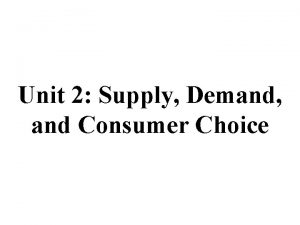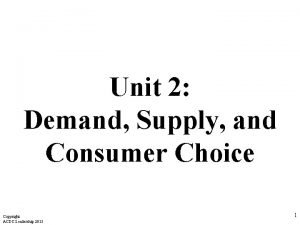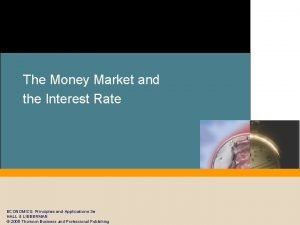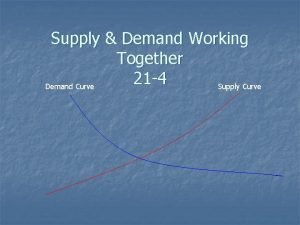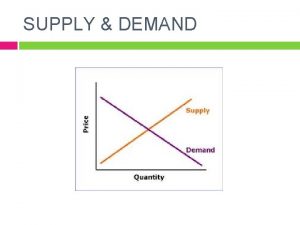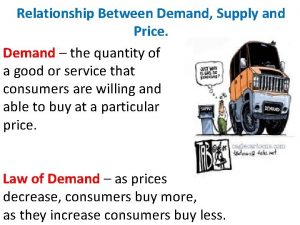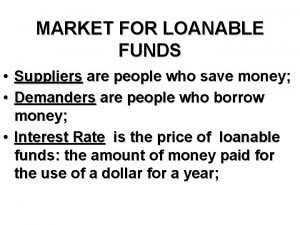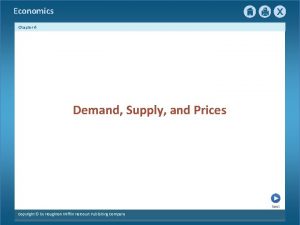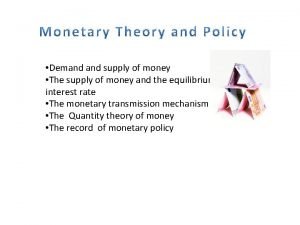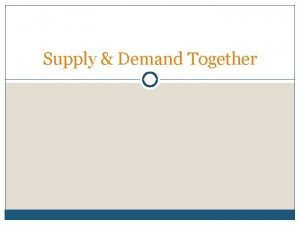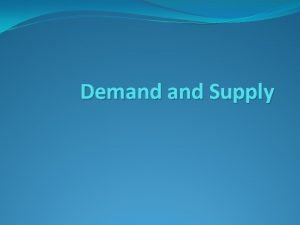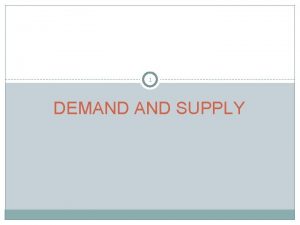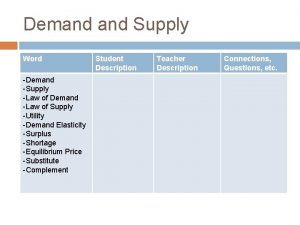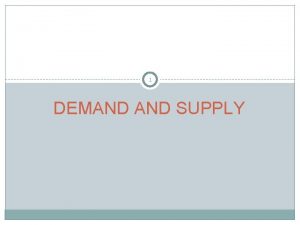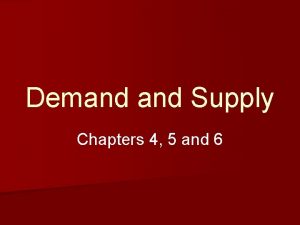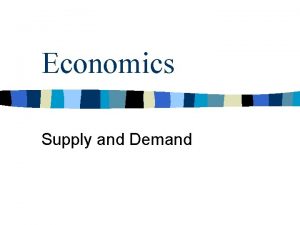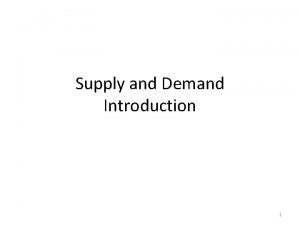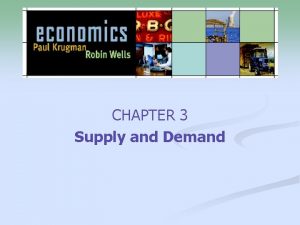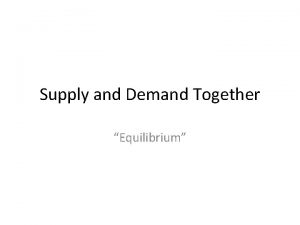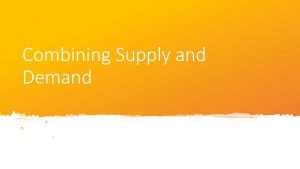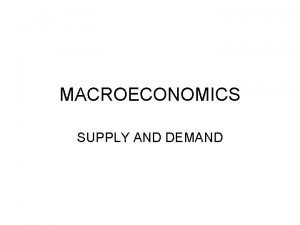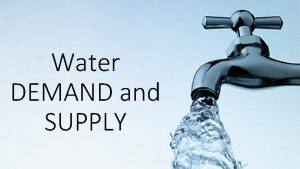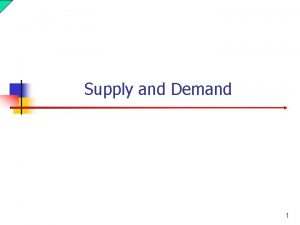Chapters 4 5 Supply and Demand Microeconomics Microeconomics





















- Slides: 21

Chapters 4 & 5 Supply and Demand

Microeconomics �Microeconomics is the area of economics that deals with behavior and decision making by small units such as individuals �Helps explain how prices are determined and how individual economic decisions are made

Demand �Demand is the desire, ability, and willingness to buy a product �Demand is a microeconomic concept �Individual demand can be shown on a demand schedule and demand curve p. 90

The Law of Demand �States that the quantity demanded of a good or services varies inversely with its price When the price goes up, quantity demanded goes down When the price goes down, quantity demanded goes up

Marginal Utility �Utility-amount of usefulness or satisfaction one gets from the use of a product �Marginal utility-the extra usefulness or satisfaction a person gets from using one more unit of a product �Diminishing marginal utility-states that the extra satisfaction we get from using additional quantities of the product begins to diminish

Donuts Demanded $35 $30 $25 price $20 $15 $10 $5 $0 0 1 2 3 Quantity 4 5 6 7

Changes in Demand �Change in quantity demanded vs. change in demand �A change in demand causes the entire demand curve to shift Income Taste Price of substitutes Price of complements Change in expectations Number of consumers

Elasticity of Demand �Elasticity-measure of responsiveness that tells us how a dependant variable such as quantity responds to a change in an independent variable such as price �Demand is elastic when a given change in price causes a relatively larger change in quantity demanded

Elasticity of Demand �Inelastic- a given change in price causes a relatively smaller change in the quantity demanded �Unit elastic-a given change in price causes a proportional change in quantity demanded

Determinants of Demand Elasticity �Can the purchase be delayed? �Are adequate substitutes available? �Does the purchase use a large portion of income?

Elasticity of Demand �How does elasticity affect profits for businesses?

Supply �Supply is defined as the amount of a product that would be offered for sale at all possible prices that could prevail in the market

The Law of Supply �The principle that suppliers will normally offer more for sale at high prices, and less at lower prices

Donuts Supplied 25 Donues Supplied 20 15 10 5 0 $0 $5 $10 $15 Price $20 $25 $30 $35

Changes in Supply �Change in quantity supplied vs. change in supply �A change in supply causes the entire supply curve to shift Cost of inputs Productivity Technology Taxes and subsidies Expectations Government regulations Number of sellers

Elasticity of Supply �Elasticity-measure of responsiveness that tells us how a dependant variable such as quantity responds to a change in an independent variable such as price �Supply elasticity is a measure of the way in which quantity supplied responds to a change in price

The Theory of Production �The Theory of Production deals with the relationship between the factors of production and the output of goods and services p. 124 �Based on the short run or long run Short run-allows producers to change only the amount of variable input called labor Long run-allows producers to adjust the quantities of all their resources, including capital

The Stages of Production �Increasing returns �Diminishing returns �Negative returns

Production Costs �Fixed cost-costs that incur even if the plant is idle and output is zero (aka overhead) �Variable cost-costs that change when the business rate of operation or output changes �Total cost- the sum of fixed and variable costs �Marginal cost- the extra cost when a business produces one additional unit of a product

Measures of Revenue �Total revenue-number of units sold multiplied by the average price per unit �Marginal revenue-the extra revenue associated with the production and sale of one additional unit of output (key measure) �Break-even point-the total output the business needs to sell in order to cover the total costs

Measures of Revenue �The profit-maximizing quantity of output occurs when marginal cost is exactly equal to marginal revenue
 Module 5 supply and demand introduction and demand
Module 5 supply and demand introduction and demand Matching supply and demand in supply chain
Matching supply and demand in supply chain Measures to correct deficient demand
Measures to correct deficient demand Difference between dependent and independent demand
Difference between dependent and independent demand Kagustuhan+kakayahan=demand
Kagustuhan+kakayahan=demand Demand forecasting and estimation
Demand forecasting and estimation Distinguish between individual demand and market demand
Distinguish between individual demand and market demand Independent demand
Independent demand Unit 2 demand supply and consumer choice
Unit 2 demand supply and consumer choice 5 determinants of supply
5 determinants of supply New grilling technology cuts production time in half
New grilling technology cuts production time in half Money market supply and demand
Money market supply and demand Combining supply and demand worksheet
Combining supply and demand worksheet Interaction of demand and supply
Interaction of demand and supply What is the relationship between supply and price
What is the relationship between supply and price Supply and demand of loanable funds
Supply and demand of loanable funds Shifters for loanable funds
Shifters for loanable funds Supply and demand economics project
Supply and demand economics project Chapter 6 section 2 supply and demand in everyday life
Chapter 6 section 2 supply and demand in everyday life Money supply curve
Money supply curve Supply demand rule
Supply demand rule Aggregate supply shifters
Aggregate supply shifters








